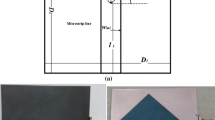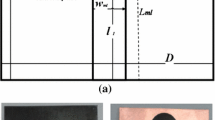Abstract
In this work, a periodic octagon split ring slot defected ground structure for MIMO (Multiple Input Multiple Output) microstrip antenna is proposed. The prototype of MIMO microstrip antenna consists of four similar rectangular microstrip antenna elements with a partition of λ/4 distance. The antennas are printed on a 1.6mm thick FR-4 substrate with an overall dimension of 62.8 X 60 mm2. To improve the antenna parameters, the proposed MIMO microstrip antenna elements are etched with narrow rectangular edge slit and ground plane defected with periodic octagon split ring slot defected ground structure (POSRSDGS). The proposed MIMO microstrip antenna resonates at dual frequency points, i.e., 4.1GHz, 5.9GHz with a bandwidth of 88MHz and 454MHz along with minimum return loss of −22.7dB and −19.02dB, respectively. The envelope correlation coefficient (ECC) is lower than the acceptable limit across the dual operating bands. Mutual coupling coefficient (MCC) at dual resonating frequency points are −36.21dB and −42.93dB, respectively. The simulated and fabricated results are found in good agreement and ideal for wireless communication applications.
Access provided by Autonomous University of Puebla. Download conference paper PDF
Similar content being viewed by others
Keywords
1 Introduction
Industry and academic sectors are predicted, future wireless communication scenarios that, 7 trillion wireless devices are serving 7.5 billion peoples. High data rates and low error rates are the essential requirments for the future generation of wireless communication systems. To achieve these requirements, many researchers recommended enabling key technology such as adding many antennas in multiple input multiple output (MIMO) array configuration [1,2,3,4,5,6,7].
The following sections of the paper is explained in a systematic way of proposed MIMO antenna design, results and discussions, and finally followed by conclusion.
2 Antenna Design
The prototype of conventional MIMO microstrip antenna (CMMA) consists of a four similar rectangular microstrip patch antenna elements with a partition of \( \lambda \)/4 distance. The antennas are embedded on FR-4 substrate with loss tangent 0.02 and thickness is 1.6mm, respectively. Separate 50 Ω microstrip feed line were excited to four patch antenna elements.The simulated and fabricated CMMA is shown in Figs.1 and 2 and dimensions are represented in Table 1, respectively.
The study carried by conventional MIMO microstrip antenna (CMMA) loaded with periodic octagon split ring slot defected ground structure (POSRSDGS) and radiating patch elements are etched with narrow rectangular slit to improve the antenna parameters and it is named as proposed MIMO microstrip antenna (PMMA). Periodic means repetition of defected ground structure unit cells with finite space. The distributions of periodic defected ground structures in the ground plane have drawn much attention for their extensive applications in antenna design [8, 9]. Figure 3 shows the optimized unit cell of octagon split ring slot defected ground structure (OSRSDGS). The geometry was obtained through simulation and final dimensions are given in Table 2. The corresponding OSRSDGS unit cell is distributed periodically in the CMMA ground plane, which are aligned with an equal spacing of ‘S’= 10 mm, vertically aligned to both radiating edges and four OSRSDGS unit cells are placed horizontal direction with a space of ‘T’=7 mm between each adjacent vertical OSRSDGS and center gap between the horizontal OSRSDGS maintained with a space of ‘R’=12 mm. The complete ground plane look like “H” shape periodic structure. Then radiating patch elements are etched with narrow rectangular edge slit. The dimensions of the narrow rectangular slits are (L1, W1) = (10 mm, 0.5 mm), are cut on the left side of the radiating inset edge patch at a distance of 1 mm from the non radiating edges are taken. Figures 4 and 5 shows the geometry and photograph of PMMA.
3 Results and Discussions
In this work, using ANSYS HFSS 15.0 Electromagnetic simulation software, antennas were designed. The whole experimental works of designed antennas are carried out by using German make Rohde and Schwarz (R&S) Vector Network Analyzer (VNA) of ZVK model (10MHz to 40MHz). The return loss characteristics of simulated and fabricated CMMA are shown in Fig. 6. The antenna resonates at 5.9GHz. The return loss obtained at the resonating frequency is equal to −21.3 dB and bandwidth equal to 204 MHz is obtained.
The return loss characteristics of simulated and fabricated PMMA are shown in Fig. 7. The antenna resonates at dual band frequency points, i.e., 4.1GHz and 5.9GHz with bandwidths of 88MHz and 454MHz along with minimum return loss of −22.7dB, and −19.02dB, respectively. Hence, by implementing the narrow rectangular slit, as well as POSRSDGS suppress, the unwanted surface wave and to control harmonics in PMMA to enhance the parameters interns of dual band resonance, bandwidth enhancement as compare to CMMA, as well as virtual size reductions are obtained. So from the Eq. (1), virtual size reduction of antenna is calculated.
where LRA is the patch length of the reference (conventional) antenna, LC is the patch length of the antenna resonating at that frequency or at reduced resonant frequencies (proposed antenna). But the width of the patch is the same at both designed and actual resonating frequencies. So that by using narrow rectangular edge slit and POSRSDGS the proposed MIMO microstrip antenna (PMMA) virtual size reduction of 30.5% is obtained.
The mutual coupling coefficient (MCC) is the major factor to be considered while designing MIMO antennas because it degrades the performance of the system. Hence, conventional MIMO microstrip antenna (CMMA) gives mutual coupling between port1 and port 2 is −20.9dB at 5.9GHz as depicted in Fig. 8 and the proposed MIMO microstrip antenna (PMMA) gives very low mutual coupling, i.e., −36.21dB at 4.1GHz and −42.93dB at 5.9GHz, respectively, is depicted in Fig. 9.
The Envelope Correlation Coefficient (ECC) for the CMMA and PMMA are shown in Figs. 10 and 11, respectively. It decides how much the communication channels are isolated. ECC can be estimated of individual elements from the S- parameters [7]. So from the Eq. (2), CMMA achieved 0.001 ECC at 5.9GHz and PMMA dual resonating frequency points, i.e., 0.35 at 4.1GHz and 0.01 at 5.9GHz.
The diversity gain is a critical parameter that must be taken into account while evaluating the MIMO antenna performance. The diversity gain (DG) has been calculated using the mathematical equation (3) using ECC. The obtained diversity gain of the CMMA is 9.9dB and PMMA is 9.53dB and 9.9dB, respectively.
Therefore, the value of ECC and DG can confirm PMMA is acceptable for MIMO operation.
The total peak gain of antenna defines the area of coverage and link budget of the wireless system. Figure 12 shows the realized peak gain of CMMA is 5.69dB at 5.9GHz. Figure 13 shows the realized peak gain pattern of PMMA. The designed antenna has peak gain dual band frequency points 1.07dB at 4.1GHz and 4.14dB at 5.9GHz, respectively.
The radiation pattern decides how antenna propagates the electromangnetic energy. The radiation pattern is studied at CMMA resonating frequency of 5.9GHz which is a broadside radiation as shown in Fig. 14. The PMMA radiation pattern is also studied for the respective resonanting frequency points. The radiation pattern at dual resonating frequency of 4.1GHz and 5.9GHz which is a broad side radiation as shown in Fig.15.
All the results of the CMMA and PMMA are summarized in Table 3. From the Table 3, it is seen that PMMA parameters shows that there is an acceptable limit across the dual operating bands.
4 Conclusion
A periodic spit ring slot defected ground structure of MIMO microstrip antenna is presented. The antenna resonates at 4.1GHz and 5.9GHz frequency. The antenna offers 88MHz bandwidth at 4.1GHz with a total peak gain of 1.07dB and 454MHz bandwidth at 5.9GHz with a gain of 4.14dB. Mutual coupling coefficients and envelope correlation coefficients at both operating frequencies are significant. This configuration also gives 30.5% of virtual size reduction. The proposed MIMO microstrip antenna (PMMA) is lightweight low profile, planar configuration, low fabrication cost, and ability to be integrated with other microwave circuits. Hence the designed antenna parameters shows that, PMMA is ideal for wireless communication applications.
References
Robert J (1981) Microstrip array technology. IEEE Trans Antenna Propag AP-29(1)
Pozar DM (1992) Microstrip antennas and arrays on chiral substrates. IEEE Trans Antenna Propag AP-40(10)
Balanis A (1993) Theory of Antennas. IEEE Trans Antenna Propag AP-41(9)
Zahn R, Shutie P (1995) Advanced antenna technologies for X band SAR. IEEE Trans Antenna Propag AP-95(2)
Han MS, Choi J (2010) Compact multiband MIMO antenna for next generation USB dongle applications. IEEE Trans Antenna Propag AP-2(10)
Chi YJ, Chen FC (2012) 4-port quadric-polarization diversity antenna with novel feeding network. In: Proceedings of the Antenna and propagation Conference
Wu D, Cheung S (2013) Design of a printed multiband MIMO antenna. In: Proceedings of the EuCAP Conference
Kumar M, Nath V (2016) Analysis of low mutual coupling compact multi band compact antenna and its array using defected ground structure. Eng Sci Technol Int J. ISSN: 2215-0986
Alhegazi A, Azawan N (2018) Compact UWB filtering antenna with controllable WLAN band rejection using defected microstrip structure. Int J Electromag Radio Eng 27(1)
Acknowledgement
We would like to thank Indian Institute of Technology Kharagpur and Gulbarga University Kalaburagi for providing licensed versions of HFSS simulation software as well as antenna measurements research facility. We are also thankful to Atlantic Engineering Enterprise ECIL, Hyderabad for providing the PCB fabrication facility.
Author information
Authors and Affiliations
Corresponding author
Editor information
Editors and Affiliations
Rights and permissions
Copyright information
© 2021 Springer Nature Singapore Pte Ltd.
About this paper
Cite this paper
Shiddanagouda, F.B., Vani, R.M., Hunagund, P.V. (2021). Periodic Octagon Split Ring Slot Defected Ground Structure for MIMO Microstrip Antenna. In: Laxminidhi, T., Singhai, J., Patri, S.R., Mani, V.V. (eds) Advances in Communications, Signal Processing, and VLSI. Lecture Notes in Electrical Engineering, vol 722. Springer, Singapore. https://doi.org/10.1007/978-981-33-4058-9_34
Download citation
DOI: https://doi.org/10.1007/978-981-33-4058-9_34
Published:
Publisher Name: Springer, Singapore
Print ISBN: 978-981-33-4057-2
Online ISBN: 978-981-33-4058-9
eBook Packages: EngineeringEngineering (R0)



















